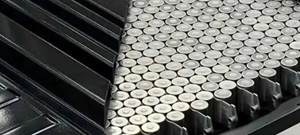P2T process positioned for recycling
British company Prodrive Composites (Milton Keynes, UK) recently issued a press release about a process, called P2T (Primary to Tertiary), for manufacturing recyclable composite components that can satisfy future end-of-life requirements without any compromise in performance.
British company Prodrive Composites (Milton Keynes, UK) is known for design and manufacture of advanced lightweight structural and non-structural composites for a wide range of applications across the automotive, motorsport, aerospace, marine, defense and other sectors. It is the first UK composites business certified to IATF 16949 (an international standard for quality management defining the requirements of a quality management system for organizations in the automotive industry) and is leading the development of some innovative manufacturing processes including the application of graphene into structural composites.
The company recently issued a press release about a process for manufacturing recyclable composite components that can satisfy future end-of-life requirements without any compromise in the performance of the original parts. Called P2T (Primary to Tertiary), the process not only simplifies recycling, but endows a composite material with the potential to fulfill three or more useful lifetimes. John McQuilliam, chief engineer, Prodrive Composites answered some questions that CW posed about the P2T process.
The process uses a reactive thermoplastic resin instead of thermoset materials and reacts the plastic monomer with a catalyst in the presence of the reinforcement material to produce a cured laminate, out of the autoclave. The reactive thermoplastic may be like Arkema’s ELIUM resin, although McQuilliam would not confirm the resin source. He did tell CW that there is no need to heat the monomer or catalyst, and that applied vacuum is used for the process, without autoclave or press. As shown in the company’s video, the process employs recycled carbon fiber mat from ELG Carbon Fibre Ltd.
According to Prodrive Composites, because the process doesn’t require an autoclave, costs are reduced so that production can be scaled up without major investment. Prodrive believes it is the first to develop this technique, which emerged through a development program with an automotive OEM customer who required a high-performance structural material with lower environmental impact than conventional composites.
“End-of-life recycling is one of the biggest debates in the composites world today,” explains McQuilliam. “The issue affects automotive manufacturers and wider industries too, such as marine, where old fiberglass boats are often broken up and sent to landfill. The main barrier to recycling has been the type of resin used; thermosetting resins predominate but these cannot be readily recycled.” He adds that thermosets were highly convenient materials to support the composites supply chain but, as tighter end-of-life regulations are introduced, better alternatives are required.
Composites produced by the P2T process can be recycled multiple times. The highest mechanical properties are obtained during first use of virgin fibers, enabling highly loaded structural items such as suspension wishbones to be manufactured. At the part’s end-of-life, the fibers and much of the resin can be recycled by chemical or thermal depolymerization, by heating the polymerized reactive thermoplastic to above its melting point to break the chains and reusing the now depolymerized material as raw material for a secondary part, such as a body panel. When the secondary part reaches the end of its life, it can be chopped and remolded into block material with properties suitable for 3D solid components. This tertiary part can itself be recycled several times until, finally, just the re-melted resin is recovered while the fibres are milled to supply other, lower grade parts.
McQuilliam tells CW that the polymerization process occurs at room temperature and that parts are intended for nominally ambient temperature use; no issues with heat distortion have been observed: “As with all composites, in-plane properties are dominated by the reinforcement and we have measured an improvement in through-thickness strength compared to epoxy resin.”
In addition to hand layup of parts, the P2T process is also compatible with advanced techniques, such as Tailored Fibre Placement (TFP). TFP makes more efficient use of the fibres than a conventional weave and is highly complementary to the P2T approach to recycling.
“This is a really exciting development which finally addresses the recycling challenges faced by composites,” concludes McQuilliam. “We have developed and refined the process and could bring new customer applications into series production within as little as twelve months.”
Watch the video to see the process:
Related Content
Mito to introduce graphene to EV energy storage innovations
Project initiatives for a multifunctional adhesive and addressing EV battery challenges are expected to change the dynamics of energy storage adoption.
Read MorePeople in composites: April 2024
TFP Hydrogen Products, Airbus SE, TPI Composites, IDI Composites International and Integrated Graphene announce new personnel and retirements.
Read MoreGIM GrapheneFibre commences commercial graphene-enriched carbon fiber production
Saudi Arabia-based company supports Saudi Arabia’s Vision 2030, contributes to full-scale graphene-based composites for a variety of end market applications.
Read MoreComposites end markets: Batteries and fuel cells (2024)
As the number of battery and fuel cell electric vehicles (EVs) grows, so do the opportunities for composites in battery enclosures and components for fuel cells.
Read MoreRead Next
Ultrasonic welding for in-space manufacturing of CFRTP
Agile Ultrasonics and NASA trial robotic-compatible carbon fiber-reinforced thermoplastic ultrasonic welding technology for space structures.
Read MoreScaling up, optimizing the flax fiber composite camper
Greenlander’s Sherpa RV cab, which is largely constructed from flax fiber/bio-epoxy sandwich panels, nears commercial production readiness and next-generation scale-up.
Read MoreNext-gen fan blades: Hybrid twin RTM, printed sensors, laser shock disassembly
MORPHO project demonstrates blade with 20% faster RTM cure cycle, uses AI-based monitoring for improved maintenance/life cycle management and proves laser shock disassembly for recycling.
Read More












